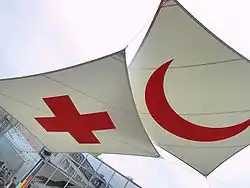Uganda Red Cross Society
Uganda Red Cross Society (URCS) was founded in 1962 and previously it was part of the British Red Cross. It has its headquarters in Kampala.
 The Red Cross and Red Crescent emblems, the symbols from which the movement derives its name. | |
| Founded | 1964 |
|---|---|
| Type | Non-governmental organization |
| Focus | Humanitarian |
| Location |
|
Area served | Uganda |
| Method | Aid |
| Website | |
The Uganda Red Cross the biggest indigenous humanitarian organization in Uganda.
History of the Uganda Red Cross
It started as a branch of the British Red Cross in 1941. In 1964 under an act of Parliament, the Uganda Red Cross Constitution was adopted bringing into existence the Uganda Red Cross Society.[1] A year later in 1965, the Society was admitted as a member of the International Committee of the Red Cross and Red Crescent Societies.
Uganda Red Cross Society has continued to grow over the years and it now has 51 branches and 30 sub-branches spanning the whole of Uganda. The National Society also works with a number of partners in the execution of its mission. These include the Government of Uganda, United Nations agencies, international funding agencies, companies and practicing sister Red Cross National Societies.
Credo

The purpose of the Uganda Red Cross society is to provide an empowered, healthy and self-sustaining community that responds to the needs of its most vulnerable. Its mission is to be a leading humanitarian agency in Uganda in saving lives, supporting livelihoods and promoting human dignity.
Principles
The work is guided by the seven fundamental principles of the Red Cross and Red Crescent movements:
- Humanity: The International Red Cross and Red Crescent Movement, born of a desire to bring assistance without discrimination to the wounded on the battlefield, endeavors, in its international and national capacity, to prevent and alleviate human suffering wherever it may be found. Its purpose is to protect life and health and to ensure respect for the human being. It promotes mutual understanding, friendship, cooperation and lasting peace among all peoples.
- Impartiality: It makes no discrimination as to nationality, race, religious beliefs, class or political opinions. It endeavours to relieve the suffering of individuals, being guided solely by their needs, and to give priority to the most urgent cases of distress.
- Neutrality: In order to continue to enjoy the confidence of all, the Movement may not take sides in hostilities or engage at any time in controversies of a political, racial, religious or ideological nature.
- Independence: The Movement is independent. The National Societies, while auxiliaries in the humanitarian services of their governments and subject to the laws of their respective countries, must always maintain their autonomy so that they may be able at all times to act in accordance with the principles of the Movement.
- Voluntary Service: It is a voluntary relief organization not prompted in any manner by desire for gain.
- Unity: There can be only one Red Cross or one Red Crescent Society in any one country. It must be open to all. It must carry on its humanitarian work throughout its territory.
- Universality: The International Red Cross and Red Crescent Movement, in which all Societies have equal status and share equal responsibilities and duties in helping each other, is worldwide.
The Uganda Red Cross Society operates throughout the country through its 51 branches and several sub branches.
References
- "Red Cross Act 1964 | Uganda Legal Information Institute". ulii.org. Retrieved 2020-03-01.